Editing the tree grid
Overview
Next Design's tree grid can display many models vertically in a tree, and at the same time, display design items for each model horizontally in columns.
This makes it suitable for viewing and editing specific design items side by side while getting an overview of the hierarchical structure of a large model.
The following describes the editing operations in the tree grid in the following order:
- Add a model
- Move a model
- Edit a field
- Collapse the tree
- Filter
- Set a color for a model
- Add a note to a cell
- Export in Excel format
- The displayed columns of the grid can be changed temporarily, but the state is not saved.
- The initial display columns of the grid can be customized in the profile.
Add a model
To add a model as a row in the tree grid, follow the steps below.
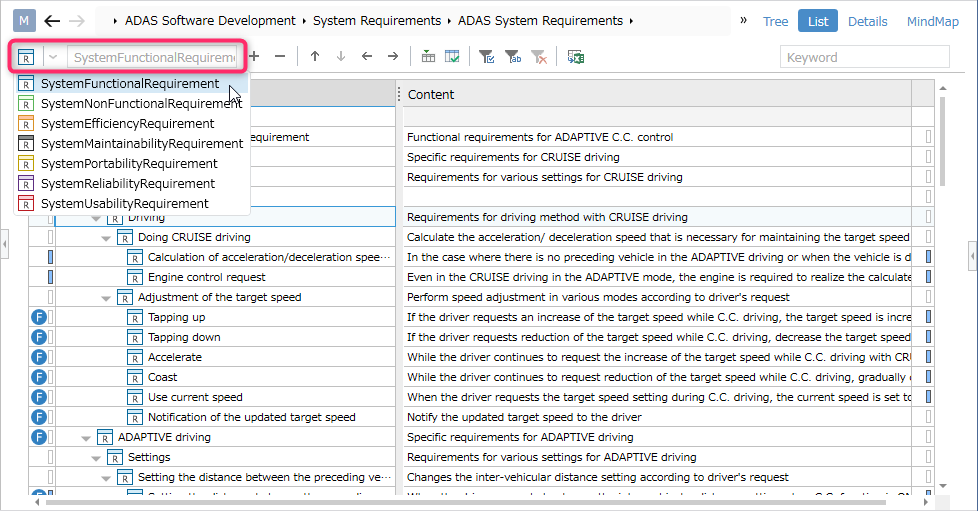
- Click the row of the parent model in the tree grid to select it.
- Open the leftmost pull-down list from the toolbar at the top of the tree grid and select the entity you want to add.
- Enter the name of the model you want to add in the text box to the right and press Enter to add the new model to the end of the children of the selected model.
Move a model
To move a model displayed as a row in the tree grid to change the hierarchical structure or change the order, follow the steps below.
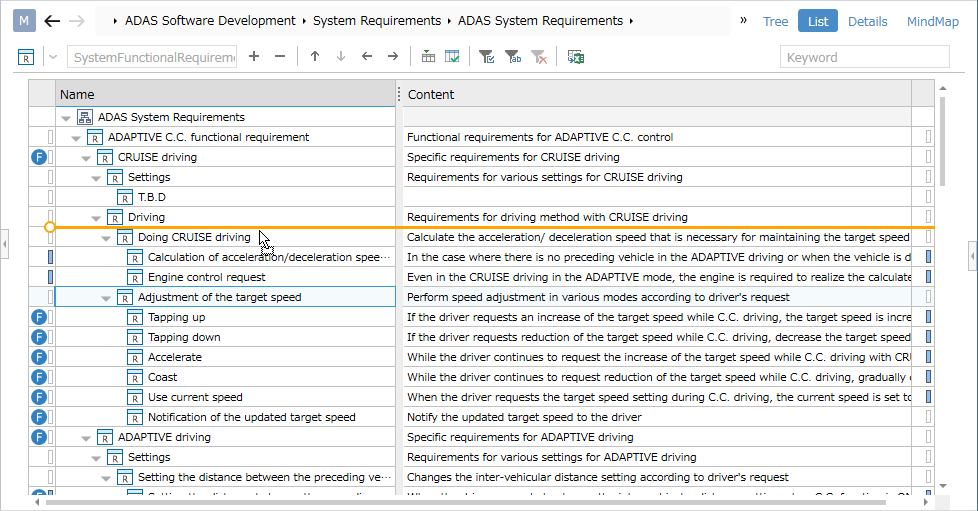
- To move a model to a different parent and change the hierarchical structure, drag the model to be moved and drop it on the new parent model.
- To change the order between sibling models, select the model to be moved and do one of the following:
- Drag and drop it between the sibling models to be moved to.
- Press the alt+up down keys.
- Click the [Order up] or [Order down] button on the toolbar at the top of the tree grid.
- To move a model up or down a hierarchical level, select the model to be moved and do one of the following:
- Press the alt+left right keys.
- Click the [Outdent] or [Indent] button on the toolbar at the top of the tree grid.
- Models in the same hierarchy are displayed classified by entity, so they cannot be moved between different entities. The order of entities can be customized in the profile.
- When moving to change the hierarchy, the entity to be moved can only be moved if it can be added to the parent entity of the destination.
Editing a field
To edit the fields of a model displayed as columns in the tree grid, follow the steps below.
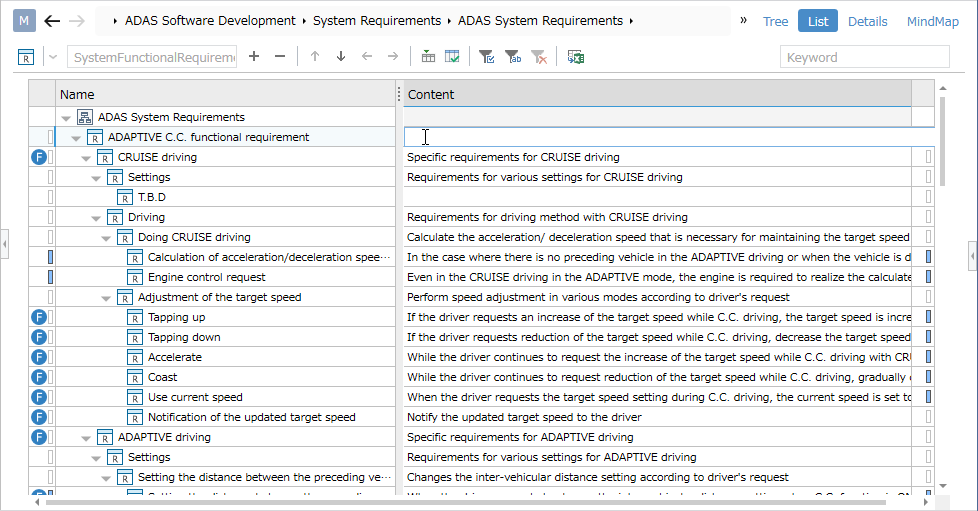
- Click or double-click a cell in the row and field column of the model you want to edit in the tree grid to select it.
- The field will be in editable state, so edit the field and confirm.
The following editing functions are provided to improve the editability of fields on the tree grid.
This allows you to edit the fields assigned to cells with an Excel-like feel.
- Autofill
- Copy the value of the selected field
- Reflect the value of the cell above
- The value copied by copying the value of the selected field cannot be pasted to Next Design in another process.
- The value copied by copying the value of the selected field can only be pasted while the project is open.
- When copying a rich text type field by copying the value of the selected field, the format is also copied.
- When pasting a value into a reference field, an association is created and pasted, rather than simply pasting a string.
This association is created by maintaining the field values common to the source class and destination class. In addition, the multiplicity constraints and path constraints of the destination field are taken into account when pasting.
Collapse the tree
To collapse or expand the tree, follow these steps.
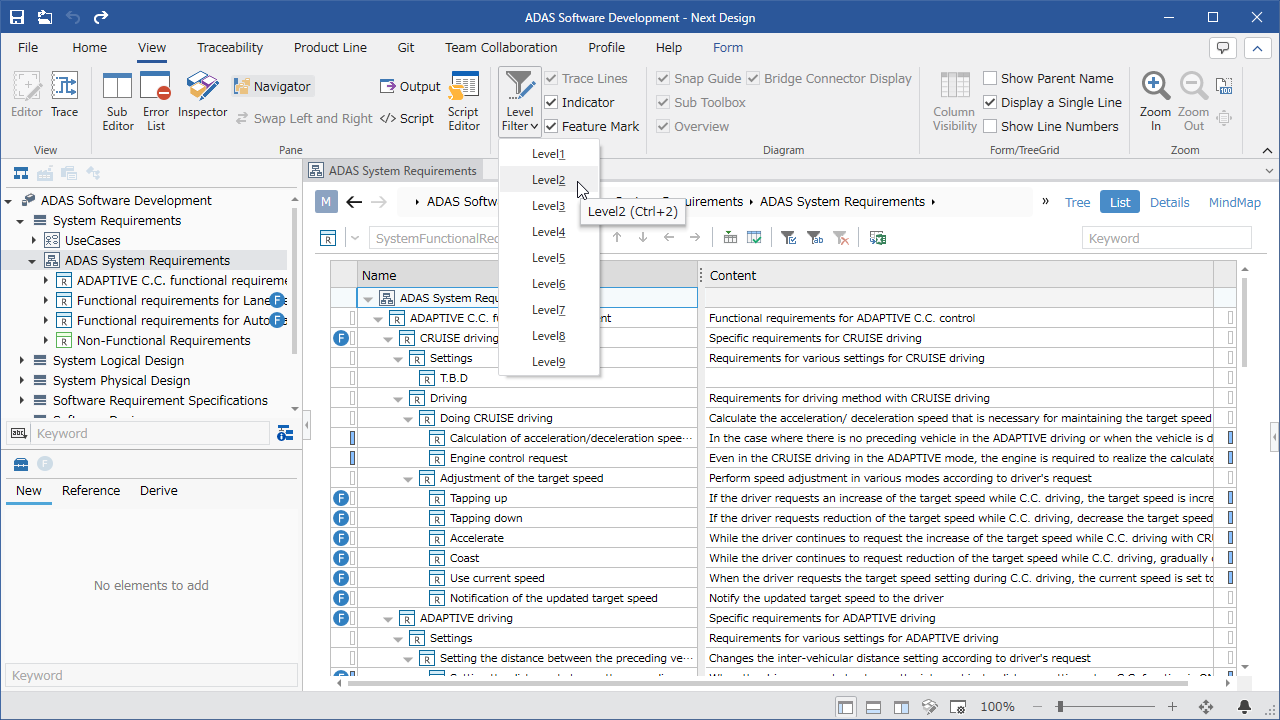
-
To toggle the expansion state of individual child nodes in the tree, click the [▲] icon that appears to the left of the model icon.
-
To change the expansion level of the entire tree at once, click the hierarchical level to expand from [View] > [Editor] > [Level Filter] on the ribbon, just like in the tree diagram.
- When using [Level Filter] on the ribbon, first click the tree grid to switch the operation target to the tree grid.
Filter
To filter to extract and display specific row elements, follow these steps.
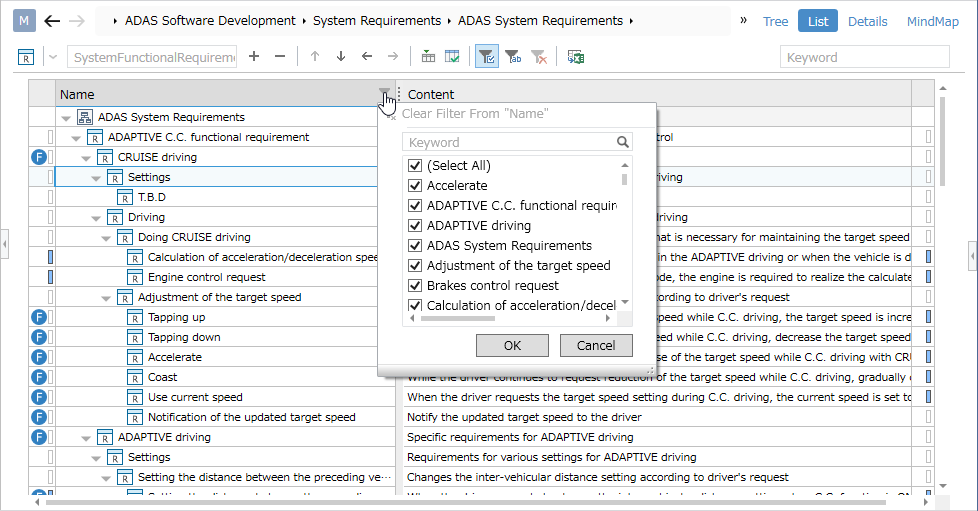
When filtering columns by keywords
- Click the [Filter columns by keywords] button on the toolbar at the top of the tree grid.
- A filter row will appear in the first row of the tree grid, so enter the [Keyword] string for the column of the field to be filtered.
- Only row elements with field values that match the entered string will be displayed in the tree grid.
- You can filter by exact match by enclosing the keyword string in double quotation marks.
- You can filter by AND condition by separating keyword strings with spaces.
- You can filter by OR condition by separating keyword strings with commas.
When filtering by combining AND and OR conditions, the AND conditions are applied first, followed by the OR conditions. Please note that the conditions are not evaluated in order from the left.
When filtering columns from options
- Click the [Filter columns from options] button on the toolbar at the top of the tree grid.
- An icon will appear in the title row at the top of the tree grid, so click the icon.
- The options will be displayed, so enable the check boxes of the options you want to display and click the [OK] button.
- Only row elements with enabled options will be displayed in the tree grid.
Setting colors to the model
To set colors to the model (tree grid rows), follow the steps below.
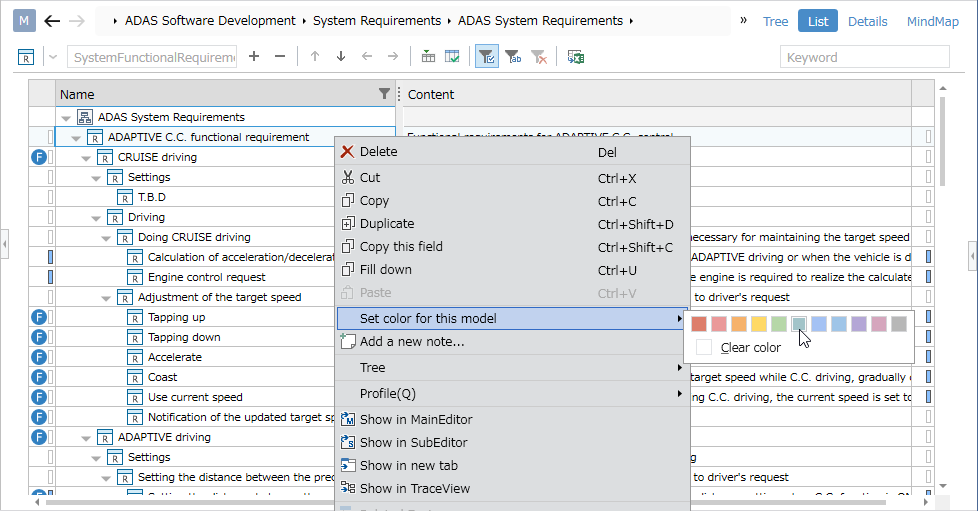
- Click the row to set color in the tree grid to select it.
- Click the color to set from [Set color to this model] in the context menu.
Add note to cell
To add a note to a cell, follow these steps:
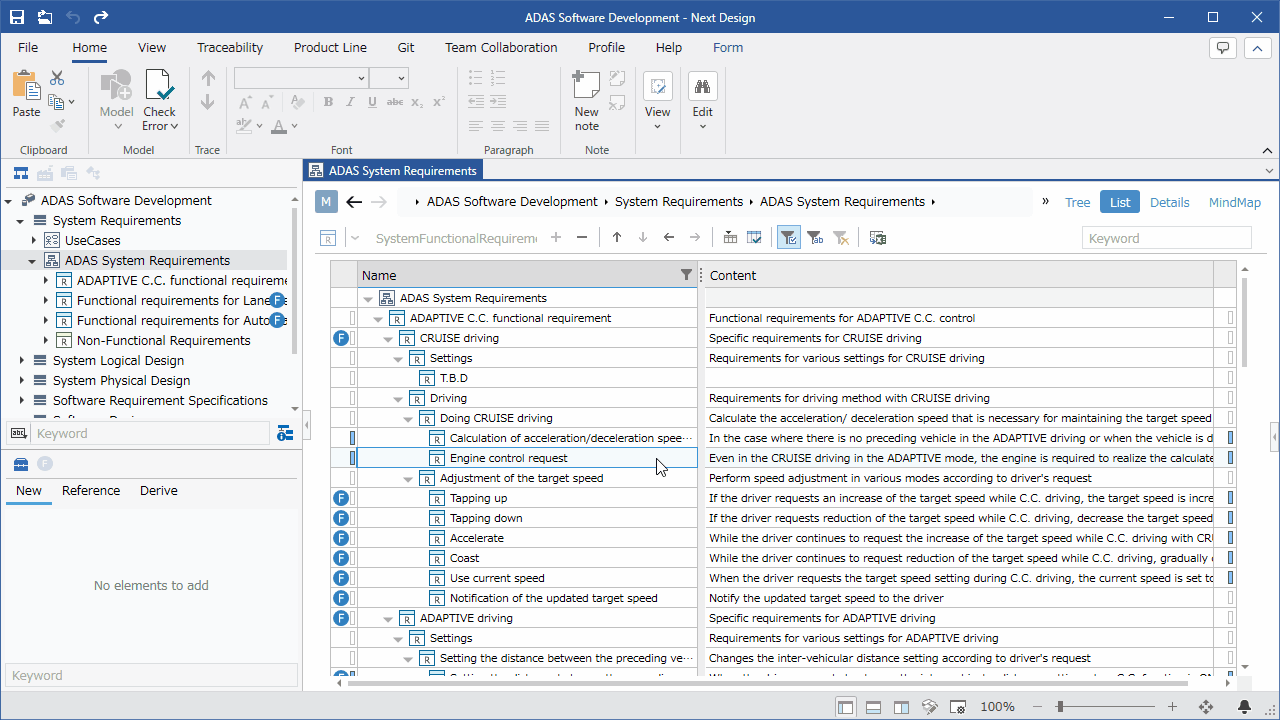
- Select the cell to add a note to in the tree grid.
- Do one of the following:
- Click [Home] > [Note] > [New note] on the ribbon.
- Click the [Add new note] command on the context menu.
- In the [New note] dialog box, enter the note and click the [OK] button.
- Changes to notes are not displayed as differences when checking model change differences.
- Notes are not copied when copying or duplicating a model to which a note has been added.
- If you redefine a field to which a note has been added in the inherited class (or delete a redefined field), the note will no longer be displayed.
- If you delete a redefined field, the note that was no longer displayed will be displayed again.
- If you convert a profile to a reference format, notes added to fields defined in the base profile (except the name field) will not be displayed.
If you delete the field that corresponds to the cell to which you added a note, the note will no longer be visible, but the note information will remain in the file. To delete notes that can no longer be displayed, run [File] > [Info] > [Manage Project Files] > [Clean Up Files] from the ribbon tab.
Export in Excel format
To export in Excel format, follow the steps below.
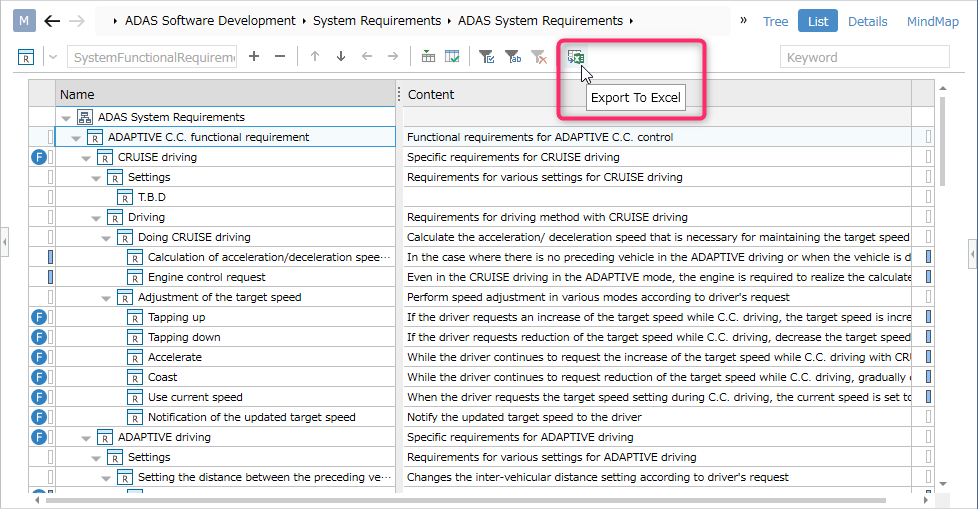
- Click the [Export to Excel] button on the toolbar at the top of the tree grid.
- In the [Export to Excel] dialog box, enter the save destination and file name, and click the [Save] button.